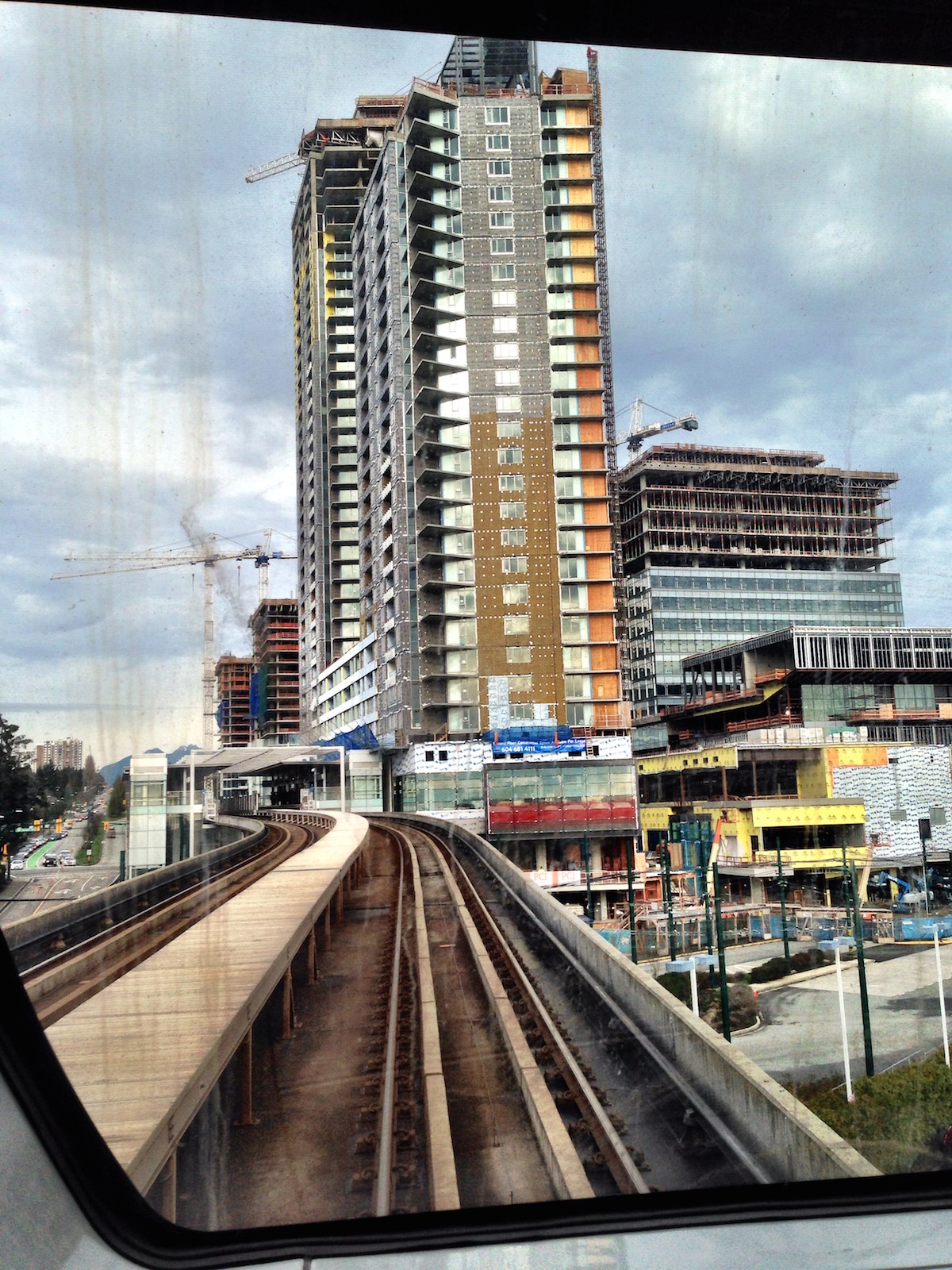From Tim Pawsey:
I shot this as we were approaching Marine Drive the other day when coming back from the airport. Yes, I’m such a kid, I have to ride in front so I can get the best view! I love the way it confirms my re-entry to the city!
.
.
I thought it was interesting just how quickly this tower was going up—and how convenient it will be once completed. The tower is so close to the actual track that it seems to me you walk right off the platform into the building lobby!
Back in another life, I moved to a tower in Montréal that was directly over the Atwater metro station. It was truly a boon to have that convenience especially in a cold climate–and it’s something I will never forget, being able to get around the city so easily, the metro at my doorstep. My hunch is that towers like this will be at a premium!
.
Question: Without rapid transit, would this complex be (a) financed and developed by the private sector, or (b) accepted and approved by the public sector – City Hall and the community?
Answer: Not a chance.
So it raises another question: Does the development community understand that, if the referendum fails, community groups will have a powerful weapon to oppose any significant new project? If, after all, the argument is that rapid transit reduces the need for vehicles and parking, alleviating the impacts on adjacent communities, then it follows: no transit, no development.














My guess is that the development community does understand these things. Notwithstanding their lack of acceptance of cycling facilities that seem as if they’re interfering with vehicular access to retail facilities, my own observation is that many other business interests also understand that mobility by walking, cycling and transit is generally in their interests. It’s the right wing “no more taxes” group that fail to understand these things. And they’re just short-sighted. They just don’t understand that the alternative – $7 billion bridges that don’t get one beyond the city limits – aren’t really in any body’s longer-term interest except maybe construction companies and politicians from rural areas focused narrowly on mobility by car and truck.
That’s also what should be built at Broadway & Commercial where 2 SkyTrain lines intersect – but isn’t….
If lack of rapid transit would banish over-scale developments like this, than put me in the No camp! This is the worst project to turn into a poster child for transit funding. Massive, blocky, on the edge of nothing and totally out of scale to the residential neighbourhood to the north.
Bob: … totally out of scale to the residential neighbourhood to the north.
In one 3-minute peak on Google Earth I counted 14 entire blocks of financially out of reach 50-foot lots within one km of Marine Drive Station. There is 11,150 m2 (2.75 acres) of land locked up in the front yard setbacks in every set of one hundred 50-foot lots, or 111, 500 m2 (27.5 ac) in every thousand. There is little greenfield land left for development, and it is estimated a million more people will arrive in the Metro before 2045 while our existing population ages.
Affordability, land availability, demographics …. these elements are bound to kibosh attempts to maintain such large tracts of land for detached housing for the wealthy under a zoning bubble. You can take issue with the form of specific developments, but Vancouver can ill afford to ignore the over-arching social, economic and housing choice benefits of living close to rapid transit.
Moreover, many of the big houses north of Marine gateway are not exactly heritage or modern architectural gems. I’d venture that if one stripped away the ubiquitous beige plaster and white or grey vinyl, you’d find inferior building materials that disintegrate after the first leak
Neighbourhood scale is only one consideration. Character is just as important, or it should be when bland mediocrity rules even where residents can afford better.
The reality is not so much “if you build it they will come,” but “if you don’t build it, where will they go?” And, more to the point, how will we all get around? If density is a given, transit hubs make sense. After all, if you can house several hundred people right on transit just 15 minutes from downtown, that has to relieve the pressure for more density in the core. As for the design of this particular tower, agreed it’s not pretty, but while it may appear to be in stark contrast it actually isn’t far removed from what else is happening along Marine Drive to the left and right and behind this image.
Indeed, we need more RAPID transit: subways, skytrains or LRTs .. not more buses crawling at the same speed as cars !
With a subway, Thomas, you get both the slow bus above and the widely spaced stations of a subway for only twice or? the price of LRT…
There will be less buses above obviously, or far fewer .. buses are just a socialist dream of less cars .. and we know socialism has failed everywhere miserably .. RAPID transit is a real game changer and attracts investments, is green and allows for prettier urban streetscapes. It will actually move people from cars .. folks like me that value their time .. and as such will allow for less congestion. That you will not get with more buses.